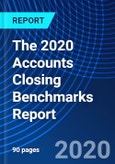A Comprehensive Assessment of the Accounts Closing Process
The 2020 Accounts Closing Benchmarks Report provides insights into the practices of Finance departments around the accounts closing process. The preparation and closing of books of accounts is a basic but key deliverable of the finance function, commanding significant resources in terms of budgets and time. Streamlining the process to make it faster, less expensive, and more efficient is something all CFOs would aspire towards. To enable this, it helps to have precise and comparable benchmarks for each aspect of the closing process so as to set measurable and realistic improvement goals internally.
Based on an in-depth analysis of 125 companies across sectors, revenue bands, and ownership categories, the 90-page report covers a wide gamut of issues around accounts closing, providing precise and well-researched benchmarks for over 60 metrics associated with the process.
Specifically, it offers benchmarks around:
- Closing timelines: Days taken to close books of accounts annually, quarterly and monthly; split of time slice by each sub-activity in the close process lifecycle
- Budgetary spends: Measures of budgetary allocation towards the accounts closing process at the overall level and splits by various categories.
- Staff allocation: Finance Full Time Employees (FTEs) and Part-Time Employees (PTEs) involved in close activities.
- Outsourcing: Extent of outsourcing of closing-related work.
- Governance mechanisms: Tools used for enabling the accuracy and visibility of the closing process.
- Automation and technology adoption: The level of automation that exists across close processes and technologies used in the process.
To enable your team to make relevant peer-set comparisons, the report provides break-downs and segmentations by 8 parameters including sector, ownership, listing, revenue, workforce size, spending, and two measures of business complexity relevant to this issue. Additionally, multi-level cross-tabulations are presented, comparing companies that are best/worst in class in terms of closing timelines, against other parameters.
Table of Contents
1. Introduction
2. Glossary of Terms
3. Methodology and Definitions
4. Survey Sample Demographics
5. Executive Summary
6. Taking Stock: Closing, Timelines, Priorities, and Challenges
7. Resources: Budget, Headcount, and Technology Spends
8. Governance
9. Automation and Technology Adoption
10. Annexure
Samples

LOADING...








